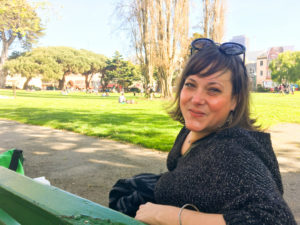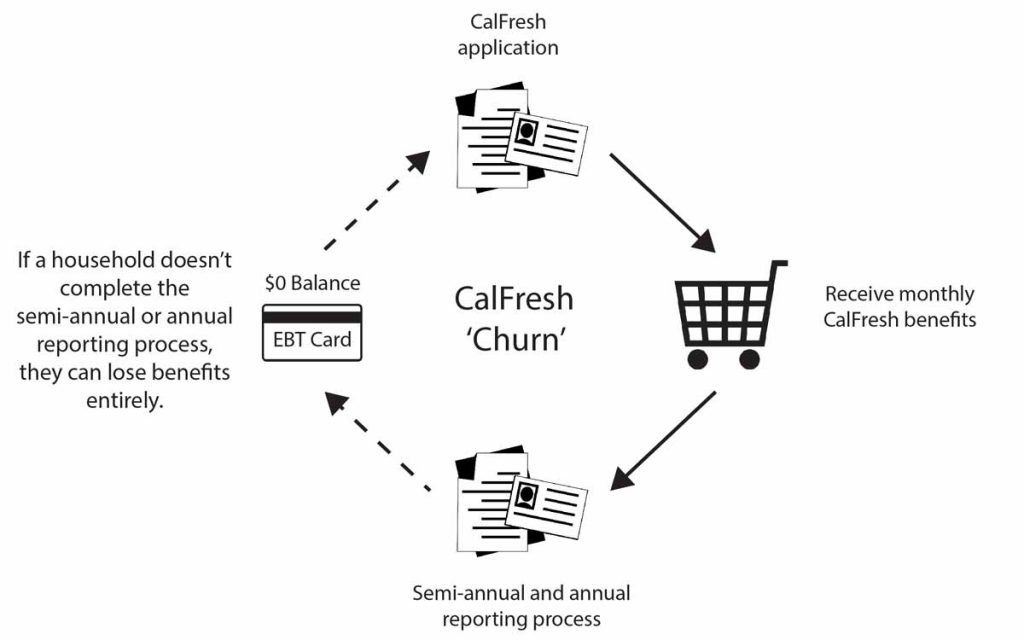Sarah breaks out her CalFresh (food stamps) EBT card at a neighborhood supermarket and gives a relieved smile because she is able to purchase the healthy, fresh vegetables that she needs to maintain and improve her health.
Every year, the Food Bank helps hundreds of neighbors like Sarah enroll in CalFresh because we know that accessing healthy food is essential for low-income neighbors who are striving to overcome challenges.
 Bad luck and broken dreams
Bad luck and broken dreams
It was several years ago when Sarah suffered a pair of episodes that cast a dark cloud over her life. In 2011, while walking up a flight of stairs on a rainy night, she slipped and tumbled over the banister, free falling two stories to the ground below. “I still have a lot of pain and range-of-motion issues, not to mention some emotional scars, from that fall,” She recounts. Then, not even a year later, her father passed away after a long illness. The pain from her fall, and the pain of losing her father combined to launch Sarah into a state of deep depression. She lost her job and eventually her apartment and became homeless.
Before these misfortunes, Sarah dreamed of owning her own health spa. She grew up in San Francisco’s Marina neighborhood in an upper-middle class home. After high school, Sarah moved to Los Angeles to “make her mark on the world.” But when her father started having health issues, she moved back to the Bay Area to be closer to him. Sarah found a job in a high-end health spa in Sausalito and really took to it. “I had a real knack for working in that place, and I thought I was going to own my own spa business one day,” she says.
Building a better life
Today, lingering health challenges have made it hard for Sarah to find work. But that hasn’t stopped her from striving for a better life. She recently secured her own apartment, is receiving treatment for her injuries, and is eating healthier thanks to her CalFresh benefits.
“I get about $180 a month through CalFresh, which is a big help by allowing me to buy fresh vegetables and protein and other things,” she says. “When I finally get back on my feet financially, I hope to stop getting CalFresh. But for now, it really is a life-saving thing for me.”
Take Action for CalFresh
Unfortunately, her worrying isn’t over. Sarah says she’s fearful that politicians will cut much of the funding for CalFresh when they vote on the 2018 Farm Bill. Losing CalFresh could send her spiraling back to her darkest days.
“If I had a chance to tell a politician about CalFresh, I would say it’s working, that it’s helping people like me be better,” Sarah says. “If anything, more money needs to be added to the program, not less, because there are people in this city who are way worse off than me.”
If you are in need of CalFresh benefits, the Food Bank’s CalFresh Outreach team can help; learn more by clicking here.
If you want to help neighbors like Sarah move forward and realize their dreams, sign up for our Policy and Advocacy Newsletter and we’ll send you alerts when we need your help with petitions and phone calls to elected officials.


 Right now, Monet juggles a full class load with a full-time job to put herself through school. But with the skyrocketing cost of housing, she has trouble making ends meet.
Right now, Monet juggles a full class load with a full-time job to put herself through school. But with the skyrocketing cost of housing, she has trouble making ends meet.
Share